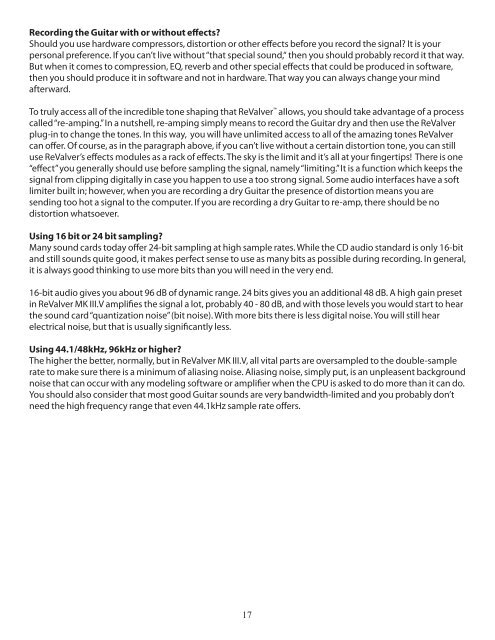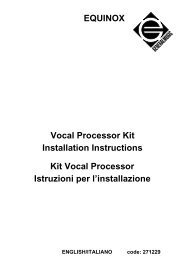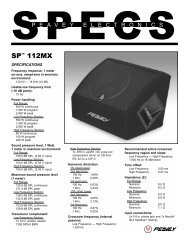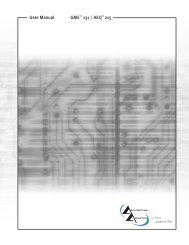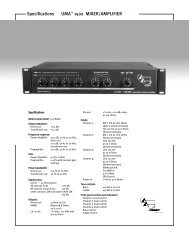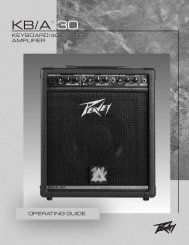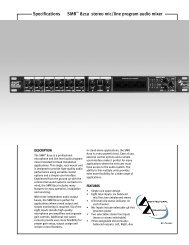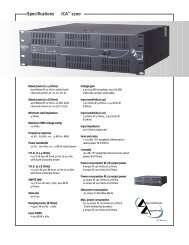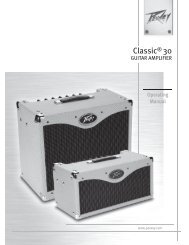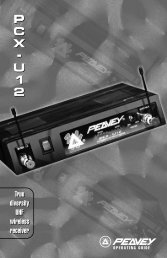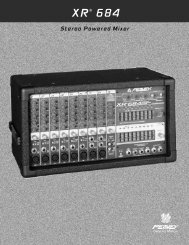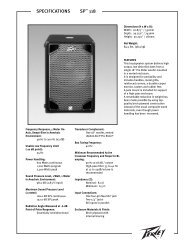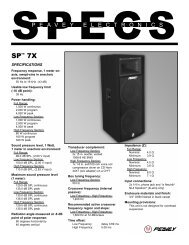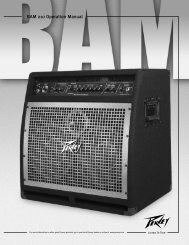Table of Contents Section Page - Peavey
Table of Contents Section Page - Peavey
Table of Contents Section Page - Peavey
Create successful ePaper yourself
Turn your PDF publications into a flip-book with our unique Google optimized e-Paper software.
Recording the Guitar with or without effects?<br />
Should you use hardware compressors, distortion or other effects before you record the signal? It is your<br />
personal preference. If you can’t live without “that special sound,“ then you should probably record it that way.<br />
But when it comes to compression, EQ, reverb and other special effects that could be produced in s<strong>of</strong>tware,<br />
then you should produce it in s<strong>of</strong>tware and not in hardware. That way you can always change your mind<br />
afterward.<br />
To truly access all <strong>of</strong> the incredible tone shaping that ReValver allows, you should take advantage <strong>of</strong> a process<br />
called “re-amping.” In a nutshell, re-amping simply means to record the Guitar dry and then use the ReValver<br />
plug-in to change the tones. In this way, you will have unlimited access to all <strong>of</strong> the amazing tones ReValver<br />
can <strong>of</strong>fer. Of course, as in the paragraph above, if you can’t live without a certain distortion tone, you can still<br />
use ReValver’s effects modules as a rack <strong>of</strong> effects. The sky is the limit and it’s all at your fingertips! There is one<br />
“effect” you generally should use before sampling the signal, namely “limiting.” It is a function which keeps the<br />
signal from clipping digitally in case you happen to use a too strong signal. Some audio interfaces have a s<strong>of</strong>t<br />
limiter built in; however, when you are recording a dry Guitar the presence <strong>of</strong> distortion means you are<br />
sending too hot a signal to the computer. If you are recording a dry Guitar to re-amp, there should be no<br />
distortion whatsoever.<br />
Using 16 bit or 24 bit sampling?<br />
Many sound cards today <strong>of</strong>fer 24-bit sampling at high sample rates. While the CD audio standard is only 16-bit<br />
and still sounds quite good, it makes perfect sense to use as many bits as pos sible during recording. In general,<br />
it is always good thinking to use more bits than you will need in the very end.<br />
16-bit audio gives you about 96 dB <strong>of</strong> dynamic range. 24 bits gives you an additional 48 dB. A high gain preset<br />
in ReValver MK III.V amplifies the signal a lot, probably 40 - 80 dB, and with those levels you would start to hear<br />
the sound card “quantization noise” (bit noise). With more bits there is less digital noise. You will still hear<br />
electrical noise, but that is usually significantly less.<br />
Using 44.1/48kHz, 96kHz or higher?<br />
The higher the better, normally, but in ReValver MK III.V, all vital parts are oversampled to the double-sample<br />
rate to make sure there is a minimum <strong>of</strong> aliasing noise. Aliasing noise, simply put, is an unpleasent background<br />
noise that can occur with any modeling s<strong>of</strong>tware or amplifier when the CPU is asked to do more than it can do.<br />
You should also consider that most good Guitar sounds are very bandwidth-limited and you probably don’t<br />
need the high frequency range that even 44.1kHz sample rate <strong>of</strong>fers.<br />
17


